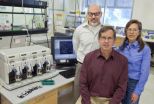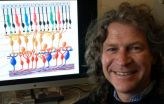(Press-News.org) Those vegetables you had for dinner may have once been protected by an immune system akin to the one that helps you fight disease. Scientists from the U.S. Department of Energy's Lawrence Berkeley National Laboratory (Berkeley Lab) and the Netherland's Wageningen University found that plants rely on a complex community of soil microbes to defend themselves against pathogens, much the way mammals harbor a raft of microbes to avoid infections.
The scientists deciphered, for the first time, the group of microbes that enables a patch of soil to suppress a plant-killing pathogen. Previous research on the phenomenon of disease-suppressive soil had identified one or two pathogen-fighting microbes at work.
But the Berkeley Lab-led team found a complex microbial network. After analyzing soil from a sugar beet field that had become resistant to a pathogen that causes root fungus, the scientists found 17 soil microbes fighting to suppress the pathogen. They also determined that all of the microbes work together to reduce the incidence of fungal infection. Their discovery that plants use a tight-knit army of soil microbes for defense could help scientists develop ways to better protect the world's food crops from devastating diseases.
"Individual organisms have been associated with disease-suppressive soil before, but we demonstrated that many organisms in combination are associated with this phenomenon," says Gary Andersen of Berkeley Lab's Earth Sciences Division. He conducted the research with fellow Berkeley Lab scientists Todd DeSantis and Yvette Piceno as well as several scientists from the Netherlands including Wageningen University's Jos Raaijmakers. Their research is published in the May 5 issue of Science Express.
The Berkeley Lab and Dutch scientists analyzed soil from a sugar beet field in the Netherlands. Something in the soil suppressed the presence of the pathogen Rhizoctonia solani, which causes root fungus in beets, potato, and rice.
The sugar beets' health followed the typical arc of plants in disease-suppressive soil: they enjoyed a few good years, then they succumbed to disease, followed by healthy beets again as pathogen-fighting microbes were activated and the soil became hostile to R. solani. To return the favor, the sugar beets funnel about a fifth of their photosynthetically captured carbon through their roots into the soil to fuel the microbes.
Disease-suppressive soils are quite common, and scientists have identified some of the microbes involved in this underground immune system. But they don't know all of the microbes that participate.
To find out, the scientists used the PhyloChip, which is a credit-card sized chip that can detect the presence of 59,000 species of bacteria and archaea in samples of air, water, and soil without the need of culturing. It was developed at Berkeley Lab to rapidly identify not only the most common and abundant organisms in an environmental sample, but also very rare types that are present in extremely small numbers. It does this by comparing a DNA sequences unique to each bacterial species with over one million reference DNA targets on the chip. The PhyloChip has shed light on many environmental mysteries, such as what's killing coral reefs near Puerto Rico and what degraded much of the oil from the Gulf of Mexico's Deepwater Horizon spill.
In this case, soil samples from the sugar beet field were modified to exhibit six levels of disease suppression. DNA was isolated from the samples and sent to Berkeley Lab for analysis. The PhyloChip detected more than 33,000 bacterial and archaeal species in the samples, with all six having more or less the same types of bacteria.
But when the scientists looked at the abundance of bacteria in each sample, they found that each had a unique fingerprint. All of the samples in which disease was suppressed had a greater abundance of 17 unique types of bacteria. These included well-known fungal fighters such as Psuedomonas, Burkholderia, Xanthomonas and Actinobacteria. In addition, other types of bacteria that have no demonstrated ability to fight pathogens on their own were found to act synergistically to suppress plant disease.
Based on this, the scientists believe that an uptick in several bacterial types is a more important indicator of disease suppression than the presence of one or two bacteria that are especially good at killing pathogens.
"We now see that the complex phenomenon of disease suppression in soils cannot simply be attributed to a single bacterial group, but is most likely controlled by a community of organisms," says Andersen.
Their research will help scientists pursue unanswered questions about disease-suppressive soil: Do plants actively recruit beneficial soil microorganisms for protection against infection? And if so, how do they do it? It will also help scientists elucidate the mechanisms by which groups of soil microbes work together to reduce the incidence of plant disease.
INFORMATION:
The research was supported in part by the California Environmental Protection Agency's State Water Resources Control Board and the Rathmann Family Foundation.
The research is described in a paper entitled "Deciphering the Rhizosphere Microbiome for Disease-Suppressive Bacteria" that is published in the May 5, 2011 issue of Science Express.
Lawrence Berkeley National Laboratory addresses the world's most urgent scientific challenges by advancing sustainable energy, protecting human health, creating new materials, and revealing the origin and fate of the universe. Founded in 1931, Berkeley Lab's scientific expertise has been recognized with 12 Nobel prizes. The University of California manages Berkeley Lab for the U.S. Department of Energy's Office of Science. For more, visit www.lbl.gov.
It takes a community of soil microbes to protect plants from disease
Berkeley Lab scientists decipher immune system for plants beneath our feet
2011-05-08
ELSE PRESS RELEASES FROM THIS DATE:
Antibodies help protect monkeys from HIV-like virus, NIH scientists show
2011-05-08
WHAT:
Using a monkey model of AIDS, scientists have identified a vaccine-generated immune-system response that correlates with protection against infection by the monkey version of HIV, called simian immunodeficiency virus (SIV). The researchers found that neutralizing antibodies generated by immunization were associated with protection against SIV infection. This finding marks an important step toward understanding how an effective HIV vaccine could work, according to scientists who led the study at the National Institute of Allergy and Infectious Diseases (NIAID), part ...
Anatomy of an outbreak
2011-05-08
GALVESTON, Texas — What causes a virus to suddenly begin infecting large numbers of people?
Scientists have long known that the process they call "viral emergence" involves a wide variety of factors. Some are changes in the environment, either generated by natural causes or human activity. Others are internal, arising from accidental changes — mutations —in the virus' genetic code.
Studying such mutations in different strains of the chikungunya virus has helped University of Texas Medical Branch researchers solve one of the most puzzling mysteries of chikungunya's ...
Forecast calls for nanoflowers to help return eyesight
2011-05-08
EUGENE, Ore. -- University of Oregon researcher Richard Taylor is on a quest to grow flowers that will help people who've lost their sight, such as those suffering from macular degeneration, to see again.
These flowers are not roses, tulips or columbines. They will be nanoflowers seeded from nano-sized particles of metals that grow, or self assemble, in a natural process -- diffusion limited aggregation. They will be fractals that mimic and communicate efficiently with neurons.
Fractals are "a trademark building block of nature," Taylor says. Fractals are objects with ...
DNA from common stomach bacteria minimizes effects of colitis, U-M study says
2011-05-08
ANN ARBOR, Mich. — DNA from Helicobacter pylori, a common stomach bacteria, minimizes the effects of colitis in mice, according to a new study by University of Michigan Medical School scientists.
The study published in Gut this month was performed by a team of investigators assembled by senior author John Y. Kao, M.D. of the University of Michigan's Division of Gastroenterology and assistant professor in U-M's Department of Internal Medicine. The findings indicate that DNA from H. pylori significantly ameliorates the severity of colitis, say lead authors Jay Luther, M.D. ...
When self-esteem is threatened, people pay with credit cards
2011-05-08
Los Angeles, CA - People shop for high status items when they're feeling low, and they're more likely to make those expensive purchases on credit, according to a study in the current Social Psychological and Personality Science (published by SAGE).
When a person's ego is threatened—by doing poorly on a task, by being told they're not as good as they hoped—people sometimes repair their self-worth by purchasing luxury goods. Because actually parting with cash can be psychologically painful, researchers Niro Sivanathan of the London Business School and Nathan Pettit of Cornell ...
No smoking policies may present challenges to treatment centers
2011-05-08
COLUMBUS, Ohio – When a new tobacco-free policy was instituted at an Ohio women's substance abuse treatment center, both smokers and non-smokers were more likely to leave treatment early in the first few months after the policy change, a new study found.
The results don't mean treatment centers shouldn't try smoking bans, according to the researchers, but they do highlight the challenges involved with implementing a new policy that goes against years of conventional thinking.
Researchers found that the number of patients who completed a program at the women's treatment ...
Study probes sources of Mississippi River phosphorus
2011-05-08
MADISON, WI MAY 5, 2011 – In their eagerness to cut nitrogen and phosphorus pollution in the Mississippi River and Gulf of Mexico, people have often sought simple explanations for the problem: too many large animal operations, for instance, or farmers who apply too much fertilizer, which then flows into waterways.
But according to new modeling research that examined phosphorus loading from all 1768 counties in the Mississippi River Basin (MRB), the true causes aren't nearly so straightforward. Livestock manure is widespread in many MRB counties, for example, but it shows ...
UT Southwestern research reveals how cancer-driving enzyme works
2011-05-08
DALLAS – May 6, 2011 – Cancer researchers at UT Southwestern Medical Center are helping unlock the cellular-level function of the telomerase enzyme, which is linked to the disease's growth.
Their latest findings, published today in Molecular Cell, demonstrate that telomerase repairs chromosomes in one of two ways – depending on whether a cell is dividing normally or if the cell is under stress from enzyme inhibition – and could lead to new or improved cancer-fighting therapies that promote inhibition of this enzyme.
"It's a significant advance in our understanding of ...
Vatican science panel calls attention to the threat of glacial melt
2011-05-08
A panel of some of the world's leading climate and glacier scientists co-chaired by a Scripps Institution of Oceanography, UC San Diego researcher issued a report today commissioned by the Vatican's Pontifical Academy of Sciences citing the moral imperative before society to properly address climate change.
The co-authors of "Fate of Mountain Glaciers in the Anthropocene" list numerous examples of glacial decline around the world and the evidence linking that decline to human-caused changes in climate and air pollution. The threat to the ways of life of people dependent ...
Spikemoss genome offers new paths for biofuels research -- bridges plant development gap
2011-05-08
WALNUT CREEK, Calif.— It's not quite Christmas, but the DNA sequence of a small plant that resembles the seasonal conifers is providing biofuels researchers with information that could influence the development of candidate biofuel feedstock plants and offering botanists long-awaited insights into plant evolution.
"When you burn coal, you're burning Selaginella's ancestors," said Purdue University botanist Jody Banks, who originally proposed that the U.S. Department of Energy (DOE) Joint Genome Institute (JGI) sequence the plant more commonly known as spikemoss as part ...
LAST 30 PRESS RELEASES:
School meals could unlock major gains for human and planetary health
Menopause hormone therapy does not appear to impact dementia risk
Signature patterns of brain activity may help predict recovery from traumatic brain injury
Dresden study uncovers new key mechanism in cancer cells
New species are now being discovered faster than ever before, study suggests
Cannabis-based products show limited short-term benefit for chronic pain, with increased risk of adverse effects
Cannabis products with more THC slightly reduce pain but cause more side effects
Clearing the brain of aging cells could aid epilepsy and reduce seizures
Brain injuries linked with potential risk of suicide, new study finds
New technique lights up where drugs go in the body, cell by cell
New study finds movement of fishing fleets can reveal shifts in marine ecosystems
Embargoed: New evidence points to potential treatment for vascular dementia
Study uncovers disrupted brain balance in alcohol dependence
Working in groups can help Republicans and Democrats agree on controversial content moderation online
Structural findings reveal how distinct GPCR ligands create different levels of activation
Anything-goes “anyons” may be at the root of surprising quantum experiments
UC review: Maximizing workplace opportunity for veterans
From generation to complex control: Metasurfaces make perfect vortex beams "within reach"
Thin-film lithium niobate-based detector: recent advances and perspectives
Exploring why some people may tend to persistently make bad choices
How cells balance their protein levels
Nirsevimab vs RSVpreF vaccine for RSV–related hospitalization in newborns
Effectiveness and impact of maternal RSV immunization and nirsevimab on medically attended RSV in US children
AI gives scientists a boost, but at the cost of too many mediocre papers
Next-generation vision model maps tree growth at sub-meter precision
Genes aren’t destiny for inherited blindness, study shows
MIT study: High-fat diets make liver cells more likely to become cancerous
Exposure to multiple fine particulate matter components and incident depression in the US Medicare population
Risk of burdensome health care spending over time in the US
Nirsevimab against hospitalizations and emergency department visits for lower respiratory tract infection in infants
[Press-News.org] It takes a community of soil microbes to protect plants from diseaseBerkeley Lab scientists decipher immune system for plants beneath our feet


